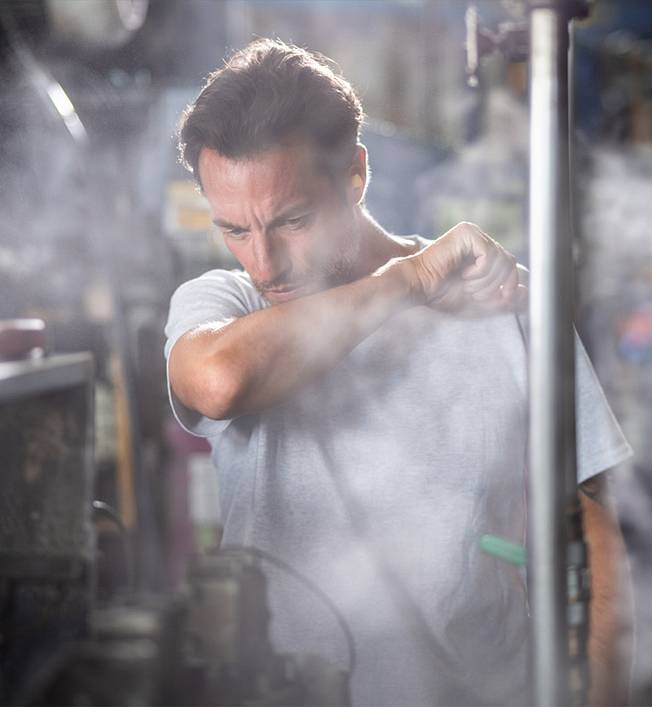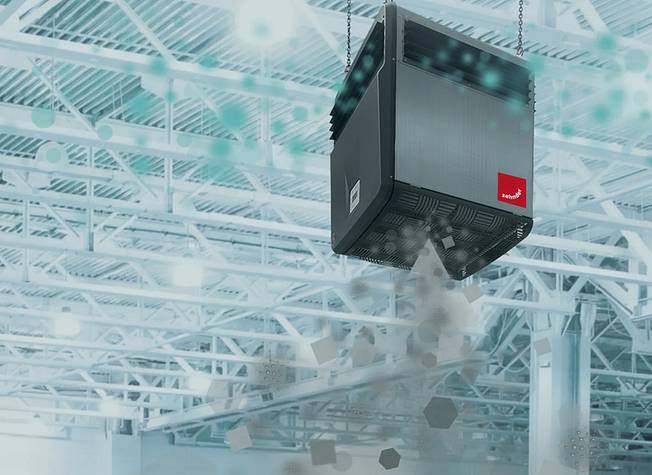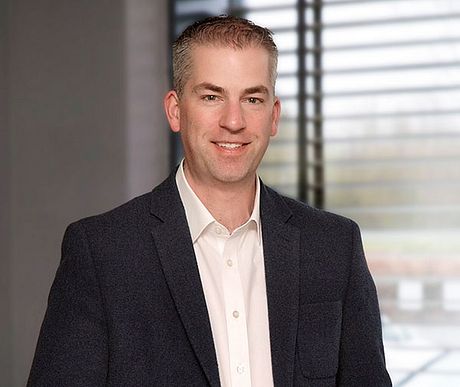
The dangerous truth about welding fume – and why you need a zero-tolerance approach
Welding fume – the health risks
Many companies try to control welding fume with spot extraction systems (LEV), cleaning and welding curtains. But all these conventional precautions offer only moderate protection from harmful fumes and the illnesses they cause.
Only a zero-tolerance approach will ensure proper protection of your whole workforce. This means collecting all welding fumes at source – and before they spread around the entire factory.
Fall short of this approach and your workers risk illnesses such as asthma, metal fume fever (also known as welding shivers), the lung disease pneumoconiosis, and even cancer.
As if this were not enough – did you know that standard LEV extraction systems pollute the environment when they blow the fumes outside?
Getting rid of welding fume – a necessity, not a luxury
The smoke produced during welding is a mixture of harmful vapours and tiny dust particles. Welding fume contains what are known as “fine” and “ultrafine” particles. Some of these are so small they are particularly dangerous to anyone breathing them in, because they can travel from your lungs into your bloodstream and other parts of the body.
Did you know it is nearly 10 times healthier to spend the day exposed to the dirt and exhaust fumes of a big city like London, than to be on the welding factory floor?
So what should you do about this? Check out our free guide for useful tips and solutions – you’re just a few clicks away.
Welding fumes – the health facts
According to the HSE, welding can produce hazardous gases including nitrous oxides and ozone.
The HSE estimates that 40 - 50 welders are hospitalised each year in the UK after breathing in metal fume at work.
Welders are at an increased risk of developing pneumococcal pneumonia. About two welders a year die of pneumonia.
Gases and fine particles in welding fume can cause dryness of the throat, coughing or tightness in the chest.
Exposure to any welding fume can cause lung cancer. It is estimated that 152 of the UK’s 200,000 welders die each year from work-related cancer.
According to the HSE, nine welders a year get asthma so severely that they can no longer work and need to claim benefits.
The “pedestrian” phenomenon: double health hazard for people without PPE than for welders
We’ve crunched the numbers and found some shocking facts. Our air quality measurements reveal that the concentration of welding fumes is actually higher away from where the welding takes place.
We found that unprotected staff working elsewhere in the factory, or walking from one area to another, can be exposed to twice as much harmful pollution as the welders themselves.
We call this phenomenon “pedestrianism”. It means, when you boil it down, that some unprotected workers would be safer standing right next to a welder than working – or walking – nearby.
The “pedestrian” phenomenon: double health hazard for people without PPE than for welders

Protect your business – from disputes and more
Let’s not beat about the bush: bad air quality at work can have dire consequences for your business.
Poor air quality can lead to employee complaints, more absences and more frequent staff turnover. If this happens, your company’s reputation is going to suffer too.
And don’t forget the Health and Safety Executive (HSE). The HSE says it will no longer accept any welding “undertaken without any suitable exposure control measures in place”.
If inspections show your business is not complying with tough regulations designed to protect workers, the HSE will have something to say about it and has the right to prosecute.
This is in addition to possible claims from staff who are able to show their working environment falls short of required standards and has caused them health problems.
In other words you need to demonstrate a zero-tolerance approach to welding fume and are not just ticking boxes. Read our free guide to understanding the dangers of welding fume and the best ways to deal with it.
The verdict? Only a comprehensive air cleaning system will give you proper protection
To ensure genuine protection for your workers, LEV fume extraction is often not enough. But LEV combined with an industrial air purification system puts you in a different league.
This combination is the mark of zero tolerance. It will thoroughly deal with welding fumes where they are produced and before they become a health risk not only to welders, but to other workers too.
And how do you do this? It’s simple really. We recommend our air purifiers because:
- they are intelligent and able to adapt to changes in air quality at your factory
- they can be customised to suit exactly what your business needs.
Your workers will repay you with satisfaction and loyalty. And your business can only get better. What’s not to love about this?
The verdict? Only a comprehensive air cleaning system will give you proper protection

Let's clear the air
Your team breathes this air every day. Let’s make it better. We’re here to answer your questions and support your needs. We’d be delighted to advise you on your air purification requirements. We take your air as seriously as we take our own.
























